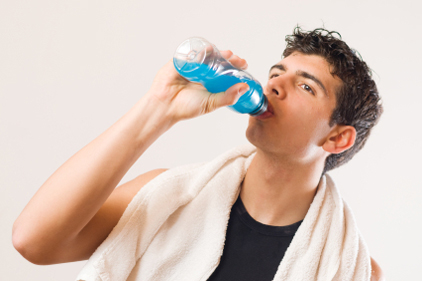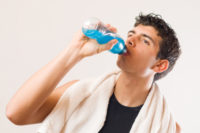Questioning Energy Drinks
New research by a behavioral neuroscience professor and her students at Centre College calls energy drinks -- and the extra boost they claim to provide -- into question.

According to the recent study, “The effect of energy drinks on visual attention task performance,” led by Centre’s KatieAnn Skogsberg, assistant professor of psychology and behavioral neuroscience, the energy drinks may be no more effective than other sources of caffeine.
While the news may be difficult for the billion-dollar energy drink industry to swallow, what initially surprised Skogsberg was the lack of scientific attention devoted to energy shot drinks.
“I came up with the research idea while standing in the grocery store checkout line,” Skogsberg says. “My husband casually wondered if the energy drinks we saw for sale really worked, and I suggested they could easily be tested using electroencephalograph, or EEG, equipment to measure brainwave activity.”
To Skogsberg, this seemed like a very straightforward experiment that would make a nice teaching tool and research project that would allow her students to try out new EEG equipment.
After an initial review of the limited available research, Skogsberg and her team of five Centre College students designed a preliminary study with a small sample size that was presented recently as a student research project at the annual meeting of the Association for Psychological Science in Washington, D.C.
“We found many studies on the effects of caffeine on brain activity and reaction time in the research literature, but none on energy drinks,” explains Skogsberg.
“Of the existing studies on energy drinks, we found only measures of the subjective effects -- how participants reported they felt -- as opposed to objective measures such as brain activity and reaction time.” Specifically, the Centre research team created a double-blind study to measure a special type of brain wave activity called the P300 involved in decision making to investigate if energy drinks affect reaction time above and beyond caffeine alone.
Now, the one-time casual observation has grown into compelling research that has garnered national and international attention.
Skogsberg cautions, however, that while the initial results were statistically significant, there is more work to be done with a larger sample size before writing up the results and submitting to a peer-reviewed publication.
While the research promises to be significant for deepening the scientific understanding of the effects of energy drinks, it also represents the exciting and interesting research opportunities that exist for students at Centre College.
The five students who worked on the initial project were Chelsea Benham, Leah Oberst, Gwynne Rose, Blaine Lewis and Katie Stevenson. Skogsberg credits Oberst with creating the initial experimental design and protocol, and Benham and Lewis for much of the experiment’s success. The duo worked tirelessly through the summer of 2012 to revise and refine the experiment that ran this past fall.
Skogsberg’s team designed a double-blind study that asked participants to complete an attention task (clicking a computer mouse button when a certain letter appeared on the screen) after drinking either water, water with caffeine, or water with 5-Hour Energy. Researchers controlled for flavor, artificial color and artificial sweeteners. During the experiment, P300 brainwaves were monitored.
In double-blind studies, both the research subjects and the experimenters are unaware of what substances are being given to which group. This experiment structure helps reduce any unintentional bias from either the researchers or the participants.
Previous research showed the P300 brainwave to increase in magnitude after a fatigued person was given caffeine, suggesting that caffeine increases alertness and attention.
The results of this initial experiment showed that those who consumed caffeinated drinks had faster brain responses, but that there was no difference in response between those who drank caffeine versus 5-Hour Energy.
As a result, Skogberg’s team concluded that the energy blend found in 5-Hour Energy does not significantly improve performance any more than caffeine alone.
Though the initial study is preliminary in nature, it opens the door to future experiments. Skogsberg and her summer student research team are already at work designing additional experiments and preparing a manuscript for publication.
Looking for a reprint of this article?
From high-res PDFs to custom plaques, order your copy today!








